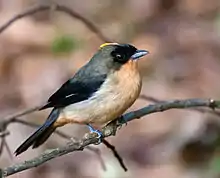Black-goggled tanager
The black-goggled tanager (Trichothraupis melanops) is a species of bird in the family, Thraupidae. It is the only member of the genus Trichothraupis. It is found at low levels in forest and woodland in a large part of eastern and southern Brazil, eastern Paraguay and far north-eastern Argentina, with a disjunct population along the East Andean slope in Peru, Bolivia and far north-western Argentina. While generally common and widespread, and consequently considered to be of least concern by BirdLife International and IUCN, the population associated with the Andes is relatively local and uncommon.
| Black-goggled tanager | |
|---|---|
 | |
| Male in São Paulo, Brazil | |
| Scientific classification | |
| Domain: | Eukaryota |
| Kingdom: | Animalia |
| Phylum: | Chordata |
| Clade: | Dinosauria |
| Class: | Aves |
| Order: | Passeriformes |
| Family: | Thraupidae |
| Genus: | Trichothraupis Cabanis, 1851 |
| Species: | T. melanops |
| Binomial name | |
| Trichothraupis melanops (Vieillot, 1818) | |
 | |
The underparts are tawny, the back and head are dull brownish-olive, and the tail and wings are contrastingly black (the latter with a white speculum that is difficult to see when perched, but conspicuous in flight). The male has a yellow crown patch and a large black patch around the eyes (the black "goggles" for which the species is named).
Taxonomy
The black-goggled tanager was formally described in 1818 by the French ornithologist Louis Jean Pierre Vieillot under the binomial name Muscicapa melanops. Vieillot based his description on the Lindo pardo copete amarillo that had been described by the Spanish naturalist Félix de Azara in 1802 based on a specimen collected in Paraguay.[2][3] The black-goggled tanager is now the only species placed in the genus Trichothraupis that was introduced by the German ornithologist Jean Cabanis in 1851.[4][5][6] The genus name Trichothraupis combines the Ancient Greek thrix meaning "hair" with the genus name Thraupis. The specific epithet combines the Ancient Greek melas meaning "black" with ōps meaning "face".[7] The black-goggled tanager is monotypic: no subspecies are recognised.[6]
Within the Thraupidae, the black-goggled tanager is a member of the subfamily Tachyphoninae and is the sister species to the grey-headed tanager in the monospecific genus Eucometis.[8]
References
- BirdLife International (2016). "Trichothraupis melanops". IUCN Red List of Threatened Species. 2016: e.T22722406A94765253. doi:10.2305/IUCN.UK.2016-3.RLTS.T22722406A94765253.en. Retrieved 11 November 2021.
- Vieillot, Louis Jean Pierre (1818). Nouveau dictionnaire d'histoire naturelle, appliquée aux arts, à l'agriculture, à l'économie rurale et domestique, à la médecine, etc (in French). Vol. 21. Paris: Deterville. pp. 452–453. doi:10.5962/bhl.title.20211.
- Azara, Félix de (1802). Apuntamientos para la historia natural de los páxaros del Paragüay y Rio de la Plata (in Spanish). Vol. 1. Madrid: Imprenta de la Hija de Ibarra. p. 398, No. 101.
- Cabanis, Jean (1850–1851). Museum Heineanum : Verzeichniss der ornithologischen Sammlung des Oberamtmann Ferdinand Heine, auf Gut St. Burchard vor Halberstadt (in German and Latin). Vol. 1. Halberstadt: R. Frantz. p. 23.
- Paynter, Raymond A. Jr, ed. (1970). Check-List of Birds of the World. Vol. 13. Cambridge, Massachusetts: Museum of Comparative Zoology. p. 295.
- Gill, Frank; Donsker, David; Rasmussen, Pamela, eds. (July 2020). "Tanagers and allies". IOC World Bird List Version 10.2. International Ornithologists' Union. Retrieved 11 November 2020.
- Jobling, James A. (2010). The Helm Dictionary of Scientific Bird Names. London: Christopher Helm. pp. 247, 390. ISBN 978-1-4081-2501-4.
- Burns, K.J.; Shultz, A.J.; Title, P.O.; Mason, N.A.; Barker, F.K.; Klicka, J.; Lanyon, S.M.; Lovette, I.J. (2014). "Phylogenetics and diversification of tanagers (Passeriformes: Thraupidae), the largest radiation of Neotropical songbirds". Molecular Phylogenetics and Evolution. 75: 41–77. doi:10.1016/j.ympev.2014.02.006. PMID 24583021.
